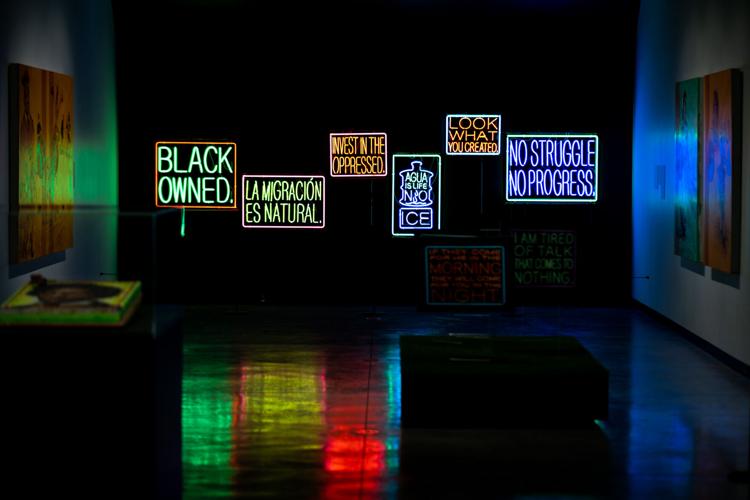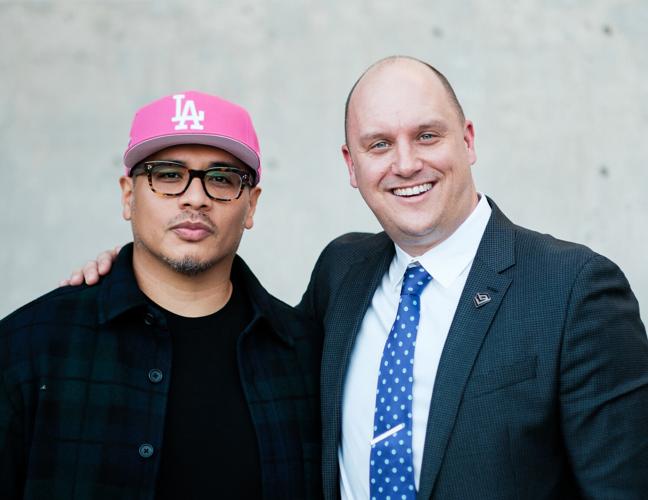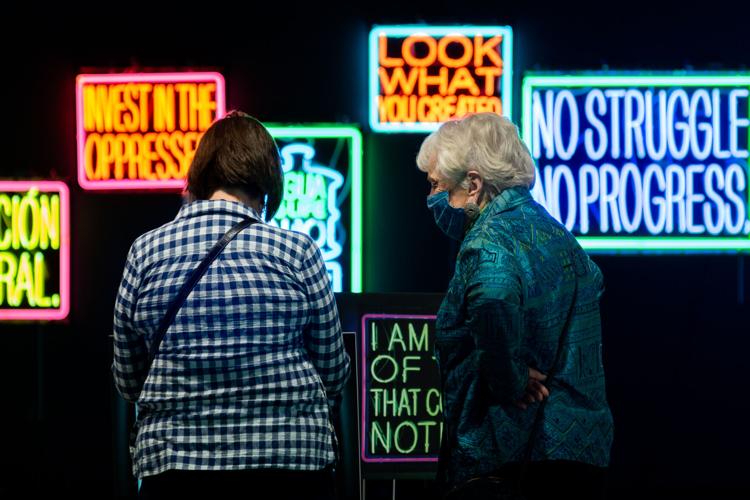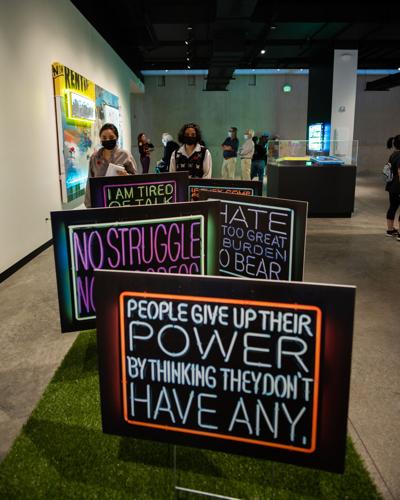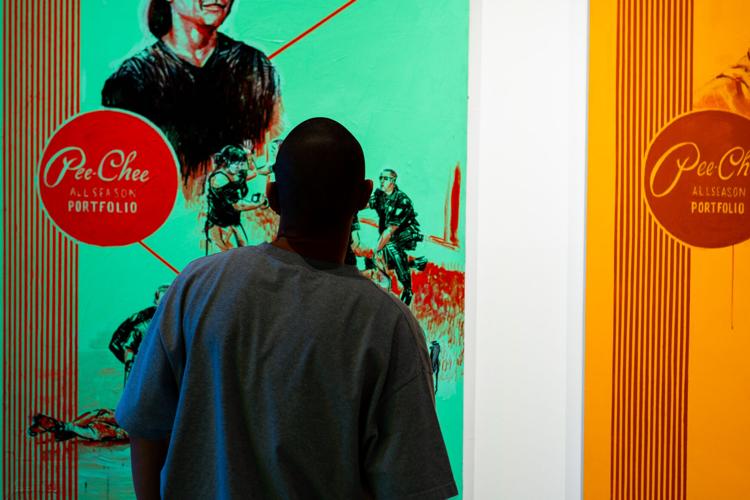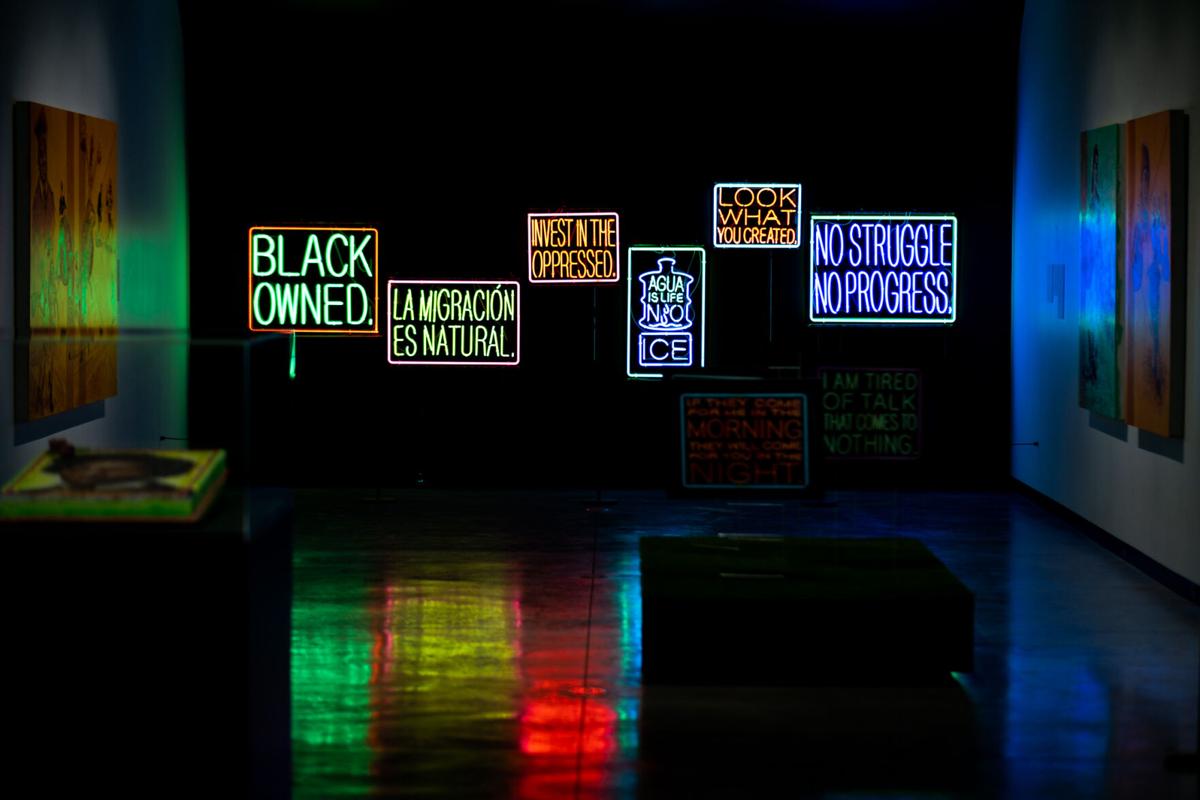In his first solo exhibition in the Southwest, draws inspiration from personal experiences, the COVID-19 pandemic and political polarization in тLook What You Created,т on display at the .
Using neon lights, acrylic sheet cakes, yard signs and more to create his multimedia exhibit, Martinez said his goal is to spark conversation about what he calls last summerтs systemic injustices, such as the killings of Breonna Taylor and George Floyd; to explore cultural loss in communities of color; and to examine how brown bodies have been historically overlooked.
тWe present work in a way that weтre not asking everybody to agree or disagree with what is in the image itself, but weтre asking you to question your position or find support in some of these statements recognizing communities of color,т said Jeremy Mikolajczak, the Jon and Linda Ender director and CEO of the museum,
Several of Martinezтs murals, such as тParadise Lost,т reimagine Mayan folklore on the sides of buildings in East L.A., with washed out graffiti, barred windows, latex paint, ceramic rose buds and a тFor Rentт sign as a nod to ongoing displacement and gentrification of communities.
His style creates what he calls a тvisual soup,т as a way to interpret his own mixed background: Mexican, Filipino and Native American.
тItтs a bunch of these conversations happening at once because thatтs how fast things are going in the city,т Martinez said during a recent interview. тA community aesthetic that is only available in certain areas now because itтs like, you know, either the properties being sold or rented out to different types of higher bidders or people that are willing to pay a certain amount.т
His art seeks to capture moments in time to represent a disappearing cultural aesthetic, he said.

Patrick Martinez, left, and museum director Jeremy Mikolajczak.
Similar issues have taken place in УлшжжБВЅ, where housing projects and commercial construction have displaced long-standing generations of ethnic communities.
тThinking about the borderland,т said Mikolajczak, тwe are in some of the conversations that heтs talking about, some of the challenges faced by individuals.т
Mikolajczak and a colleague came across Martinezтs work in 2016, noticing the piece тProtest Pee Chee,т an acrylic panel of Colin Kaepernick kneeling in protest, along with other athletes Billie Jean King, Peter Norman, Tommie Smith and John Carlos reimagined on a yellow Pee-Chee stationery folder. The piece is part of a police-brutality series called тSidelined.т
The images of police brutality in some of Martinezтs works may force the viewer to confront a lack of accountability in a deeply divided nation, he said, whereas the тsubtle violence,т in regards to the displacement of bodies, may offer a glimpse into an experience that not all museum goers identify with. Together, these sentiments serve as a way to challenge authoritarian systems of power and information, Martinez said.

Lawn signs by Patrick Martinez.
His technique of balancing covert and apparent messages is a tactic used by many artists to introduce social and political context, similar to the work of artist and associate professor at the , Aaron Coleman.
Coleman, who is on the collections committee for the TMA, was enthusiastic about Martinezтs work and wrote a caption for тKingdom Undone,т a washed-out blue, stucco mural in the exhibit. As a person of color himself, Coleman said, he identifies strongly with Martinezтs artwork.
тI think heтs definitely talking about the political nature of the world we live in but there are also references to Indigenous peoples, migration and immigration, obstacles that migrants face when theyтre trying to get into this country through invisible lines,т Coleman said. тI think there are people who are going to feel seen and heard by Patrickтs work and people whose feathers are going to get ruffled.т

Patrick Martinez, тLook What You Created,т at УлшжжБВЅ Museum of Art.
Expanding the conversation
The TMA seeks to expand the conversation with its visitors, taking into account complex and triggering social issues and considering how to create a space for individuals to respond to the work, Mikolajczak said.
тYou can get this holistic experience when you come here and have two totally different perspectives and experiences when you travel through the museum,т Mikolajczak said.
The museum searches for diverse artists whose work can speak to multiethnic collections such as Latin American art, Indigenous art, the African diaspora, Asian communities and more, the curator said.
тFor Patrick, you have both the influence of the Latin American perspective, the indigenous perspective, the Latinx perspective, the Chicano movement,т Mikolajczak said. тAll of these aspects come together and merge in Patrickтs work.т

Neon signs by Patrick Martinez.
The idea of being a тcultural outsiderт comes with a level of anxiety, said Alejandro Macias, a UA assistant professor of art. тI think dealing with identity is something that is very present in our works,т Macias said.
Macias, whose views are a byproduct of growing up in the border town of Brownsville, Texas, was impressed by the versatility of Martinezтs artistic practice and wrote the caption for Martinezтs work тHold the Ice,т a neon sign in the shape of a water jug on plexiglass.
The strong messages Martinez conveys are also illustrated on his acrylic cake pieces of recognizable social justice figures, Macias said.

Pee-Chee by Patrick Martinez.
In his тSidelined,т series, Martinez seeks to memorialize people of color such as George Floyd, Ahmaud Arbery and Breonna Taylor in contrast to portraits that historically were mostly of affluent white men, such as in classical European art.
тI think about the flip side of European portrait painting, white men being painted with dark backgrounds,т Martinez said. тTheir skin is glowing and they look important and what I want to do is paint them in a same kind of light, the techniques of a European scope to render their portrait, but do it differently.т
His incorporation of familiar products or relics of community customs such as sheet cakes, neon signs and nostalgic stationery is an attempt to invite the museum visitors to look beyond the flashiness of colors and to have conversations about equity and humanity, Martinez said.
If you go
тLook What You Createdт will be on display in the Kasser Family Wing of Latin American Art at the УлшжжБВЅ Museum of Art until April 24.
Martinez, will return to УлшжжБВЅ on Feb. 9 to participate in the УлшжжБВЅ Museum of Artтs Leadership Circle Lecture Series to discuss his exhibit. The lecture will be held from 6 to 7:30 p.m. in the Stonewall Foundation Community Room, in the Alice Chaiten Baker Center for Art Education, , and is free for museum members. The entrance fee of $5 is for non-members.

